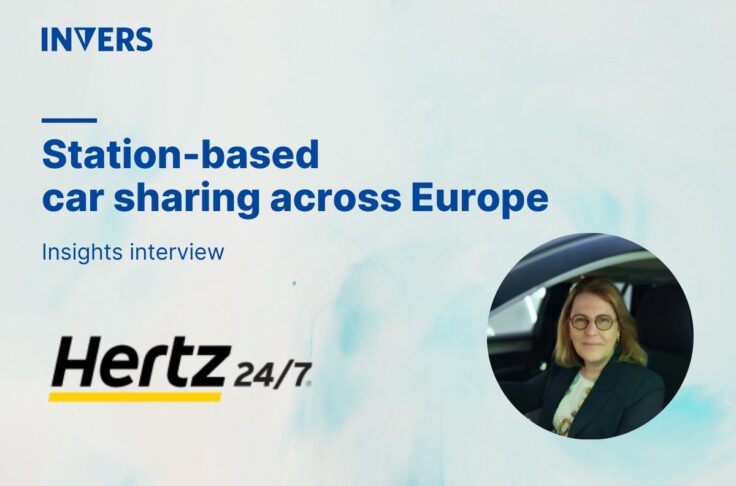How to Address Challenges and Opportunities in Moped Sharing
Summary
- The more options, the better. Moped sharing fills in the gap for middle-distance trips. But overcoming challenges related to infrastructure (ie: on-street charging, curbside parking) and profitability (ie: city fees, permits) need to be addressed on both the city and operator level to make moped sharing work in North America.
- New safety measures from Revel have decreased crashed rates by 50% from June to September. Addressing user behaviour is key to creating safer riders.
- There has been a growing demand for long-term rentals due to people prioritizing health over convenience during the pandemic. Subscription services and bike libraries are new ways to meet this need and increase the accountability users have for shared micromobility vehicles.
- The micromobility space overall needs to slow down and refocus on building a long-lasting service that people can rely on for the next 5-10 years, not just in the next few months. People need to be confident they can rely on a mix of shared mobility services in order to not be dependent on their private vehicle.
- Making micromobility accessible to everyone starts with the urban design of cities and bringing more diverse groups to the planning table. Operators also have a responsibility to work with the community and understand what access means to them, and incorporate it into their operations.

The mobility revolution will be on two wheels. It won’t be with kick scooters, though. Instead, we believe mobility will further evolve if cities in North America adopt moped sharing. While moped sharing has taken off in Europe and Asia, only a few cities currently enjoy the benefit of moped sharing in North America.
In order to understand why this was the case, we invited moped sharing experts to discuss what is needed to bring this form of mobility to North America.
- Daniella Henry, Associate Director – Policy at Revel
- Tony Ho, VP Global Business Development at Segway
- Kerby Olsen, Shared Mobility Supervisor at Oakland Department of Transportation
- Sandra Phillips, CEO and Founder, movmi
At the start of the discussion, we polled audience members on what their thoughts on moped sharing were: 53% said ‘we need more of them on our streets’ and 40% had ‘no opinion yet’. This was an opportunity to start the conversation about moped sharing and begin shaping a future with more options in the transportation ecosystem.
How does moped sharing fit into the micromobility landscape?
According to Sandra Phillips of movmi, one shared mode is not better than the other. She uses the analogy of a Swiss Army knife – a tool that has multiple knives for multiple purposes. Similarly, in shared mobility, there are multiple modes and vehicle types available to fulfill multiple trip purposes. The goal should be to use all the different types of shared mobility services to avoid “carmageddon”. Instead of having more private vehicles on the road, we need more shared mopeds, shared cars, and any other shared vehicle.
Daniella Henry from Revel has first-hand experience in managing shared mopeds in North America. From her perspective, there are several advantages to mopeds, with the main one being that is fulfills more than a first-last mile need. Pre-pandemic, the average trip length was 3 miles on shared mopeds. Recently, trips have been averaging 4 miles. This shows that people are using Revel’s moped sharing service for essential trips throughout the city. Because people depend on the service, Revel has found that ridership is not impacted by the weather. Instead, users add on extra layers to continue using Revel’s mopeds throughout the year.
Kerby Olsen, who coordinates shared mobility services with the City of Oakland’s Department of Transportation, agrees and says different types of vehicles meet different needs. A kick scooter is great for trips under 1 mile, a bike for 1-1.5 miles, and a car for 2.2 miles and more. Mopeds are suitable for the middle-distance trips. In addition, mopeds have a fun factor associated with it – the open air, wind in hair feeling adds another element to the experience.
Tony Ho from Segway sees the lack of mopeds and moped sharing in North America due to the way road infrastructure is built and the culture emphasizing cars. Many European and Asian cities are moped-friendly, with smaller roads, better regulation for mopeds, and overall more dense. Mopeds are replacing cars in other parts of the world because it’s a more affordable option. More choices give consumers the ability to pick the vehicle that works for them.
What are some of the infrastructure challenges in moped sharing?
Kerby from the City of Oakland highlights how his team is figuring out how to facilitate on-street charging. He says that because you are dealing with utilities and city infrastructure, it becomes a harder aspect to solve. Nonetheless, the city recently installed its first curbside EV charging to make electric vehicles easier to use.
Kerby also talks about increasing the efficiency of curbside space. Specifically, the City of Oakland allows users to park perpendicular to the curb. This has worked well so far, as it allows the city to use a piece of the curb space more efficiently and increase the capacity of the curb without making any big changes that require large investments. Data also plays a key role in further improving curb space usage. In addition, utilization data from Revel helps determine which curbs need more moped parking, or even designated Revel parking, based on demand from users.
What are the safety concerns in moped sharing and how are they addressed?
Daniella emphasizes that safety is an integral component across the company and within teams at Revel. Implementing safety measures is more than just checking a box. Instead, Revel’s approach to safety is iterative and continual, working with city partners and community groups to holistically improve safety measures. User education needs to happen to improve user behaviour, and there are also suspensions and warnings given if users are not following the rules.
Two key safety measures that Revel recently implemented are safety training and helmet selfies. The safety training requires users to answer 42 questions before getting on their first ride. Due to the importance of these new safety measures, Revel made already registered users take the questionnaire before allowing them on a moped again. Daniella explains that the questionnaire was developed with an external company that looked at the intersection of behavioural science and policy, allowing the questions to better shape positive user behaviour.
The second safety measure takes place before every trip gets started. The moped won’t turn on unless users unlock the helmet case and take a selfie of themselves wearing the helmet. This additional process is geared towards changing user behaviour, much like how a car starts beeping if you do not have your seatbelt on. Both users and cities have responded positively to these changes. In fact, Daniella shares that in New York City, Revel’s crash rates were 50% lower in September after implementing these new safety measures, compared to June when these steps weren’t in place.
In terms of safety of the moped from theft and vandalism, Daniella says that Revel’s decision to use full-time staff instead of gig workers have allowed them to stay on top of what is happening with the fleet. With full-time staff, the operations team can check in on different vehicles as needed instead of just checking off the maintenance tasks for different vehicles. Daniella says it is also important to build connections with parking enforcement and safety and crime agencies to have broader oversight on the mopeds to keep them running.
What are some ways to improve profitability for moped sharing operators?
Sandra from movmi differentiates between increasing revenue and increasing profitability. There are different opportunities to add in new revenue streams, but it is critical to look at profitability. Because transportation is a slim margin business, operators, and even cities, need to look at how costs can be reduced. Many cities have decided to charge micromobility operators a fee for each vehicle or just a flat rate overall. However, this does not contribute to micromobility operators achieving profitability and being able to provide their service in the long-run. Fortunately, cities are re-evaluating their fee structure and reshaping it to better build more livable communities with active forms of transportation.
Tony from Segway shares the same sentiments on profitability and sees this starting with the build of mopeds. Compared to kick scooters, mopeds are a more mature product by design. There are industry standards on how mopeds should be made, so it becomes easier to develop and align with city regulations. At the same time, this means moped manufacturers can focus on the innovative side of product development to help operators overcome the operational challenges and be in a better position for profitability. For example, product innovation to increase utilization rates such as dynamic repositioning and self-charging will reduce the maintenance and staffing resources needed. Overall, there needs to be a network effect to further improve the operational efficiencies. Innovations with self-charging vehicles would require communication between docking stations, city infrastructure, and more.
Kerby from the City of Oakland adds that even though infrastructure is what cities can control, cities should be equally concerned with supporting operators towards profitability. Micromobility services provide additional options for people to travel around the city. These additional options have become an essential service that cities are relying on private operators to provide. Kerby clarifies that the fees cities are charging operators are based on a cost recovery model – in other words, operators are simply paying for the costs that cities are incurring from administering or coordinating their service in the city. Nonetheless, those are fees that could push operators from profitable to unprofitable, and there could be a different way to structure transportation fees on a higher level to further encourage shared and electric transportation services.
What can be done on the regulatory level to make moped sharing and shared mobility in general more viable across regions?
Daniella from Revel says that having a regional approach to moped sharing regulations have helped with extending business areas across municipal boundaries. With Revel, users can go from Berkeley to Oakland without any hassle. Having coordination across cities in a regional agreement brings standardization to regulatory, insurance, and other needs that help operators enter markets. Currently, Daniella sees data requirements different across cities, so that would be an additional area for collaboration.
Kerby from the City of Oakland sees multiple opportunities to get people more connected by better integrating shared mobility and public transit. This could be with a fare card integration, where a public transit pass could be used across different moped sharing, carsharing, and other shared options. There could also be pilot projects along bus rapid transit routes where first-last mile trips made to transit hubs by shared and electric vehicles are subsidized by grants. A low-income user program would also broaden the reach and accessibility of shared mobility services. In addition, MaaS (mobility-as-a-service) could play a role in connecting the transportation ecosystem together in one convenient app.
Has there been a shift from shared micromobility to owned micromobility?
Tony from Segway saw a growth in private kick scooter ownership in the retail market and predicts this year will be even stronger. Within the shared mobility space, he sees an opportunity for a slight tweak in the business model to a quasi-ownership model with subscription services. Subscription services tailor to longer-term rentals, which in turn would make users feel like they own the vehicle and be liable for any damages, therefore having more accountability to take care of the vehicle.
Sandra from movmi echoes the need for longer term rentals. In a survey movmi conducted in Vancouver during the summer pandemic months, 61% of people prioritized health when choosing their mode of transportation. In this context, health looks at individuals’ comfort in choosing a mode that reduces potential contamination or transmission of COVID-19. Sandra explains that health had never been a factor in determining people’s transportation choice. It has always been about convenience, speed, and cost. While this finding is more relevant in the current environment than in the future, it still provides the demand for increased adoption of subscription models within shared mobility.
Kerby highlights the City of Oakland’s bike library program to fill the need for medium to long term rentals. In order to give more people access to bikes, the city purchased 500 e-bikes and worked with community-run, non-profit bike shops in Oakland. A range of different e-bikes are offered, from the standard e-bike to adaptive and cargo e-bikes to meet different needs, all available at a low or even no cost. For participating bike shops, they facilitate the process of borrowing the e-bikes, just like you would with a book at a library. For the City of Oakland, this initiative provides people access to a clean transportation mode that they may not otherwise be able to afford.
As a result of the pandemic, Revel has also offered day passes for long-term rentals, which have had a positive impact on ridership. In addition, Revel also started offering helmets for users to purchase at-cost, which provides additional hygiene measures to those who want more precautions.
Is there a saturation point in micromobility? Will there ever be too many micromobility vehicles?
75% of the audience members agree that the more micromobility options, the better. Kerby from the City of Oakland goes into further detail and explains that an ecosystem allows people to forgo car ownership – the ultimate goal of shared mobility. People need confidence they will have access to an ecosystem of different forms of different types of trips. In addition, people need the reassurance that the service they rely on now will still be available 5-10 years down the road, not just in the next few months. Kerby believes that the micromobility space, as a result, needs to slow down and build mobility services for the long-term.
Sandra from movmi gives the example of carsharing in Vancouver. At one point, there were four carsharing services operating in Vancouver, two with the free floating model and two with the station-based model. Overall, users enjoyed increased reliability and the high competition created a better experience and service for users. A recent project movmi ran in Vancouver involved private-partnerships with the transit agency and local carshare and bikeshare service to offer access using the public transit card. In a follow-up survey, a user shared that the public transit card now gave her the confidence that no matter where she was during the day and at what time, she would have a way to get around.
Tony from Segway sees growing technology advancements helping with utilization. In his opinion, the reason why there is litter of kick scooters on sidewalks is because there are too many of them, but also because they are underutilized. Instead of having more micromobility vehicles on the street, there needs to be less of them that are better used within a smart network. This network would allow for using the same vehicle for both personal, shared, and commercial use. But to achieve this network effect, there needs to be coordination and collaboration between companies, all orchestrated by cities.
What needs to be done to make micromobility more accessible to everyone?
Daniella from Revel believes that operators need to embrace an approach that increases equity and provide transportation to people who may not have many options. The ability to purchase a moped and insurance should not be a barrier to accessing a moped; in fact, Revel supports moped accessibility to low income individuals by providing 40% off each ride. Daniella emphasizes that by listening to community experts and understanding what access means to them, operators can have a long-term vision on how to incorporate better accessibility into the service. There isn’t a one-size-fits-all approach to equity, so it is important to find creative ways to help communities learn and embrace new modes of transportation. For example, having group rides for women and gender non-conforming individuals will help them feel more comfortable on a moped.
Kerby from the City of Oakland sees accessibility to low income, minority communities being a chicken and egg problem. Operators have told him that they can’t make money in those areas and there needs to be a culture of using new micromobility options. Cities have a responsibility of supporting operators to reach people in these areas. If the micromobility service is losing money but getting more people to more jobs, then from a society’s perspective it’s working, so perhaps cities need to subsidize these trips. Just like universal basic income, there can be universal basic mobility.
Sandra from movmi sees accessibility and equity being addressed through urban design. Historically, cities have been planned by a male-dominated industry. A better approach would be to hear from different groups of people to have an urban design that is suitable for people with disabilities, families, and more.


